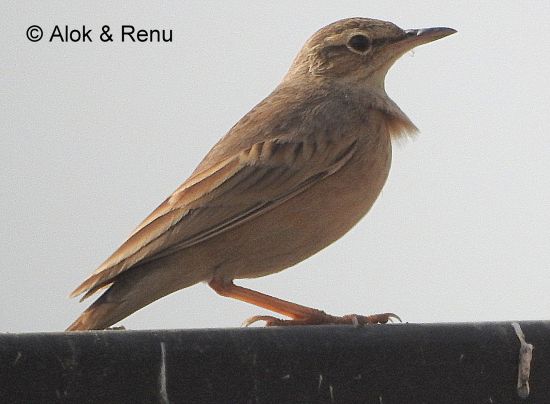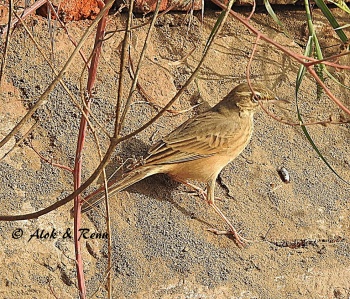(rearrange photos) |
|||
| (10 intermediate revisions by 7 users not shown) | |||
| Line 1: | Line 1: | ||
| − | + | [[Image:long-billed_pipit_alok_2.JPG|thumb|550px|right|Subspecies ''A. s. decaptus''<br />Photo by {{user|aloktewari|Alok Tewari}}<br />Khijadiya Bird Sanctuary, Jamnagar, Gujarat, [[India]], Dec-2017]] | |
| − | + | ;[[:Category:Anthus|Anthus]] similis | |
| − | [[Image: | + | '''Includes: Bannerman's Pipit''' |
==Identification== | ==Identification== | ||
| − | + | 17–20 cm | |
| − | + | *Sandy grey upperparts | |
| + | *Whitish or pale buff underparts | ||
| + | *Streaked breast | ||
| + | ====Similar Species==== | ||
| + | Similar to the [[African Pipit]], but has a heavier build, less-clearly marked face and under parts, a buffy outer tail, and usually a longer bill. Best identified by the display and call. | ||
==Distribution== | ==Distribution== | ||
| − | [[Africa]] and | + | [[Image:long-billed_pipit_alok.JPG|thumb|350px|right|Subspecies ''A. s. jerdoni''<br />Photo by {{user|aloktewari|Alok Tewari}}<br />Gurgaon, Haryana, [[India]], Dec-2016]] |
| + | '''Northern Africa''': occurs only in [[Egypt]]<br /> | ||
| + | '''Western Africa''': [[Senegambia]], [[Senegal]], [[Guinea]], [[Mali]], [[Sierra Leone]], [[Liberia]], [[Ivory Coast]], [[Ghana]], [[Togo]], [[Nigeria]], [[Niger]], [[Chad]], [[Cameroon]], [[Gabon]], [[Congo]], [[Democratic Republic of Congo]], [[Angola]], [[Zaire]]<br /> | ||
| + | '''Eastern Africa''': [[Sudan]], [[South Sudan]], [[Eritrea]], [[Ethiopia]], [[Somalia]], [[Kenya]], [[Uganda]], [[Rwanda]], [[Burundi]], [[Tanzania]], [[Zambia]], [[Mozambique]], [[Malawi]]<br /> | ||
| + | '''Middle East''': [[Syria]], [[Lebanon]], [[Israel]], [[Jordan]]<br /> | ||
| + | '''Arabian Peninsula''': [[Saudi Arabia]], [[Yemen]], [[Oman]], [[United Arab Emirates]], [[Kuwait]], [[Iran]], '''Asia''': [[Afghanistan]], [[Nepal]]<br /> | ||
| + | '''South Asia''': [[Pakistan]], [[India]], Eastern and Western [[Himalayas]], [[Bangladesh]], [[Bhutan]]<br /> | ||
| + | '''Southeast Asia''': [[Indochina]], [[Myanmar]] | ||
==Taxonomy== | ==Taxonomy== | ||
| − | == | + | [[Nicholson's Pipit]] was recently split from this species. |
| − | + | ||
| − | == | + | ====Subspecies==== |
| − | |||
| − | + | This species has 15 subspecies<sup>[[#References|[1]]]</sup>: | |
| + | *''A. s. bannermani'': Mountains of south-western [[Mali]], [[Guinea]], [[Sierra Leone]], northern [[Liberia]] to western [[Cameroon]] | ||
| + | *''A. s. captus'': [[Lebanon]], [[Syria]], [[Israel]], [[Palestine]] and western [[Jordan]] | ||
| + | *''A. s. arabicus'': South-western, southern and south-eastern [[Arabian Peninsula]] | ||
| + | *''A. s. sokotrae'': [[Socotra]] Island | ||
| + | *''A. s. chyuluensis'': [[Kenya]] and northern [[Tanzania]] | ||
| + | *''A. s. asbenaicus'': Southern Sahara in central and eastern [[Mali]] and central [[Niger]] | ||
| + | *''A. s. jebelmarrae'': Mountains of western and central [[Sudan]] | ||
| + | *''A. s. nivescens'': Mountains of south-eastern [[Egypt]]; coastal Red Sea in north-eastern Sudan to northern Kenya | ||
| + | *''A. s. hararensis'': highlands of [[Eritrea]], [[Ethiopia]], Kenya, and northern Tanzania | ||
| + | *''A. s. dewittei'': Highlands of eastern [[DRC]], south-western [[Uganda]], [[Rwanda]], [[Burundi]], and [[Angola]] | ||
| + | *''A. s. decaptus'': Southern [[Iran]] to western [[Pakistan]]; winters to north-western [[India]] | ||
| + | *''A. s. jerdoni'': Mountains of eastern [[Afghanistan]] to western [[Nepal]]; winters to north-central India, [[Bangladesh]] | ||
| + | *''A. s. similis'': Peninsular India (Bombay to Karnataka and western Tamil Nadu) | ||
| + | *''A. s. travancoriensis'': South-western India | ||
| + | *''A. s. yamethini'': Central [[Myanmar]] | ||
| + | Subspecies ''bannermani'' from western [[Africa]] is sometimes split as ''Anthus bannermani'', Bannerman's Pipit. | ||
| + | ==Habitat== | ||
| + | Rough stony hillsides with sparse vegetation. | ||
| + | ==Behaviour== | ||
| + | ====Breeding==== | ||
| + | Ground nesters; the clutch consists of 2-4 eggs. | ||
| + | ====Diet==== | ||
| + | Their diet includes insects such as grasshoppers, crickets and beetles; seeds and grit. | ||
| + | ==References== | ||
| + | #{{Ref-Clements6thAug21}}#Avibase | ||
| + | #Handbook of the Birds of the World Alive (retrieved March 2015) | ||
| + | #Wikipedia | ||
| + | {{ref}} | ||
==External Links== | ==External Links== | ||
{{GSearch|Anthus+similis}} | {{GSearch|Anthus+similis}} | ||
| − | [[Category:Birds]] | + | {{GS-checked}} |
| + | <br /> | ||
| + | <br /> | ||
| + | |||
| + | [[Category:Birds]] [[Category:Anthus]] | ||
Latest revision as of 00:29, 10 October 2022

Photo by Alok Tewari
Khijadiya Bird Sanctuary, Jamnagar, Gujarat, India, Dec-2017
- Anthus similis
Includes: Bannerman's Pipit
Identification
17–20 cm
- Sandy grey upperparts
- Whitish or pale buff underparts
- Streaked breast
Similar Species
Similar to the African Pipit, but has a heavier build, less-clearly marked face and under parts, a buffy outer tail, and usually a longer bill. Best identified by the display and call.
Distribution
Northern Africa: occurs only in Egypt
Western Africa: Senegambia, Senegal, Guinea, Mali, Sierra Leone, Liberia, Ivory Coast, Ghana, Togo, Nigeria, Niger, Chad, Cameroon, Gabon, Congo, Democratic Republic of Congo, Angola, Zaire
Eastern Africa: Sudan, South Sudan, Eritrea, Ethiopia, Somalia, Kenya, Uganda, Rwanda, Burundi, Tanzania, Zambia, Mozambique, Malawi
Middle East: Syria, Lebanon, Israel, Jordan
Arabian Peninsula: Saudi Arabia, Yemen, Oman, United Arab Emirates, Kuwait, Iran, Asia: Afghanistan, Nepal
South Asia: Pakistan, India, Eastern and Western Himalayas, Bangladesh, Bhutan
Southeast Asia: Indochina, Myanmar
Taxonomy
Nicholson's Pipit was recently split from this species.
Subspecies
This species has 15 subspecies[1]:
- A. s. bannermani: Mountains of south-western Mali, Guinea, Sierra Leone, northern Liberia to western Cameroon
- A. s. captus: Lebanon, Syria, Israel, Palestine and western Jordan
- A. s. arabicus: South-western, southern and south-eastern Arabian Peninsula
- A. s. sokotrae: Socotra Island
- A. s. chyuluensis: Kenya and northern Tanzania
- A. s. asbenaicus: Southern Sahara in central and eastern Mali and central Niger
- A. s. jebelmarrae: Mountains of western and central Sudan
- A. s. nivescens: Mountains of south-eastern Egypt; coastal Red Sea in north-eastern Sudan to northern Kenya
- A. s. hararensis: highlands of Eritrea, Ethiopia, Kenya, and northern Tanzania
- A. s. dewittei: Highlands of eastern DRC, south-western Uganda, Rwanda, Burundi, and Angola
- A. s. decaptus: Southern Iran to western Pakistan; winters to north-western India
- A. s. jerdoni: Mountains of eastern Afghanistan to western Nepal; winters to north-central India, Bangladesh
- A. s. similis: Peninsular India (Bombay to Karnataka and western Tamil Nadu)
- A. s. travancoriensis: South-western India
- A. s. yamethini: Central Myanmar
Subspecies bannermani from western Africa is sometimes split as Anthus bannermani, Bannerman's Pipit.
Habitat
Rough stony hillsides with sparse vegetation.
Behaviour
Breeding
Ground nesters; the clutch consists of 2-4 eggs.
Diet
Their diet includes insects such as grasshoppers, crickets and beetles; seeds and grit.
References
- Clements, J. F., T. S. Schulenberg, M. J. Iliff, S. M. Billerman, T. A. Fredericks, J. A. Gerbracht, D. Lepage, B. L. Sullivan, and C. L. Wood. 2021. The eBird/Clements checklist of Birds of the World: v2021. Downloaded from https://www.birds.cornell.edu/clementschecklist/download/
- Avibase
- Handbook of the Birds of the World Alive (retrieved March 2015)
- Wikipedia
Recommended Citation
- BirdForum Opus contributors. (2024) Long-billed Pipit. In: BirdForum, the forum for wild birds and birding. Retrieved 12 May 2024 from https://www.birdforum.net/opus/Long-billed_Pipit
External Links
GSearch checked for 2020 platform.




